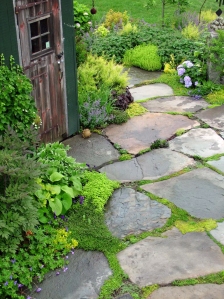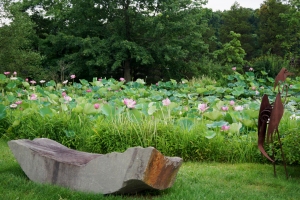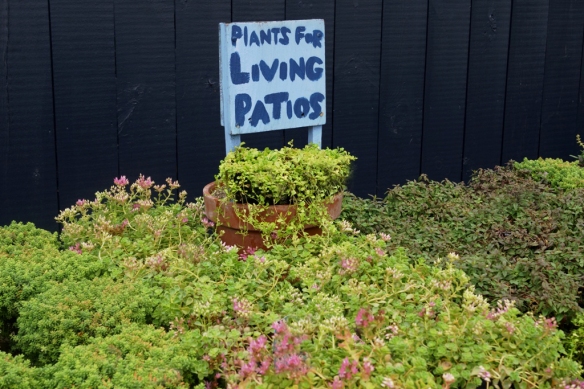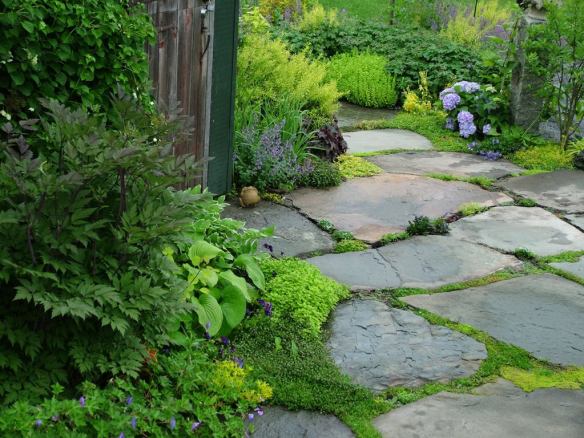
When you visit Linden Hill Gardens for the first time, it’s easy to get overwhelmed by the sheer quantity of cool plants and beautiful gardens. But when you take the time to really appreciate the design aspects — particularly the hardscaping — you’ll understand why owner Jerry Fritz is widely known as a landscape craftsman as well as a plant addict. One of the signature features of Jerry’s design work is his use of stone: a material he incorporates into his own gardens as well as those he creates for clients.

From a practical standpoint, stone is much more durable and much less maintenance than wood. Wood, after all, eventually rots and needs to be replaced. Painting or staining may delay the process a few years, but that also increases the investment of time and money over the years. A properly constructed stone wall, path, or terrace, on the other hand, can last a lifetime.

Another reason why Jerry likes to use stone so much — and why he encourages others to use it as well — is its aesthetic appeal. This natural material complements all kinds of plantings, and its presence helps to link the garden to its setting in the larger landscape.

Walls, of course, are one of the most common uses for stone in the garden. In a sloping site, stone retaining walls set against the grade can terrace the area into flatter, more useful spaces. If a site is already flat, you can build stone walls and fill behind them with soil to create raised areas, or line excavated spaces with stone walls to develop a sunken garden. In any site, free-standing stone walls are a classic choice for creating boundaries and defining spaces within a garden.

Why is it that builders and homeowners continue to create walkways by pouring boring concrete slabs and then sticking brick or flagstone on top as a veneer? In our cold-winter climate, the freezing temperatures cause the bricks or stones to break loose, and regular repointing is necessary to put them back in place. There’s a much simpler approach: excavate approximately 2 feet down, backfill with gravel, pack it firmly, and set in one or more large slabs of fieldstone or granite. The finished effect is more elegant, essentially maintenance-free, and often more cost-effective over the long run.

For secondary paths, pea gravel or crushed stone is often a good choice. It makes a nice scrunching sound underfoot, and it looks good, too. Plus, it’s more environmentally friendly than a solid path, because it allows rainwater to drain through and soak into the soil instead of run off the site. Installing gravel paths can be a good way to spread out landscaping costs over time, as well: Walk on them as they are for a few years, then use them as the base for stone slabs to create the permanent walkway as money allows.

“Living patio” is a name Jerry came up with for natural fieldstone slabs in a dry-pack (unmortared) setting, with spaces left between the stones for plants to grow in. You can find out more about how Jerry designs and plants a feature like this in Bring Your Patio to Life.

A stone seat is very easy to construct, visually dramatic, and more cost-effective than a teak garden bench. Find a fairly flat stone and lay it across two chunky logs for a rustic seat, or set it on two blocky base stones to create a permanent feature. Or, find one large stone that serves as a bench all by itself. Jerry likes to create a special sitting area by placing a stone bench in a space cut into a slope. It’s especially nice when a site like this faces south, because the stone warms up quickly, making a cozy spot to sit from fall through spring. He has also designed stone chaise lounges with fragrant thyme plants around the edges to sit or lie on.

If you’re planning a water feature for your garden, don’t forget to incorporate stone. Use it to make the edging, to add height for a waterfall, or to form the base for a bubbling fountain element. Add a unique look to a pond by setting in large boulders with the tops as level as possible just above the water surface.

Long, narrow, large stones look amazing when set on end and partially buried for support. A single standing stone makes a dramatic garden accent; a pair emphatically marks an entrance or transition point. Where space allows, repeating the stones in lines, circles, or spirals creates a very powerful landscape feature.

Even short stone posts can be useful as well as beautiful, serving to mark edges, protect borders from errant garden hoses, or elevate special bits of small statuary.

Look for these and other stone features the next time you stroll through the gardens at Linden Hill. Interested in adding stone to your own landscape? Please see Our New Client Process information for details on how we work.





























